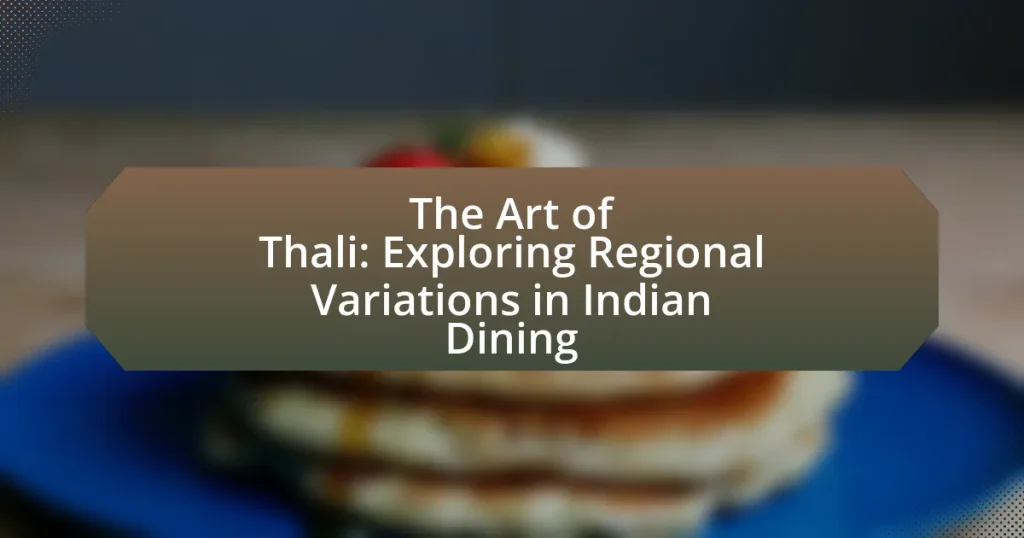The main entity of the article is the concept of Thali in Indian dining, which refers to a traditional meal served on a single platter that includes a variety of dishes representing different regional flavors and textures. The article explores how Thali reflects Indian culture and tradition, its historical origins, and its evolution over time. It details the key components and typical dishes found in Thali, highlighting regional variations across North, South, East, and West India. Additionally, the article discusses the etiquette and best practices for enjoying a Thali meal, as well as recommendations for experiencing authentic Thali dining in restaurants and at home.

What is the concept of Thali in Indian dining?
The concept of Thali in Indian dining refers to a traditional meal served on a single platter, featuring a variety of dishes that represent different flavors and textures. Thali typically includes staples like rice or bread, accompanied by lentils, vegetables, pickles, and sometimes meat or fish, showcasing the diversity of regional cuisines across India. This communal style of dining emphasizes balance and variety, allowing diners to experience a complete meal in one sitting, which is rooted in the cultural practice of sharing food.
How does Thali represent Indian culture and tradition?
Thali represents Indian culture and tradition by showcasing a diverse array of regional dishes served on a single platter, reflecting the country’s culinary richness and communal dining practices. Each Thali typically includes various items such as rice, bread, lentils, vegetables, and sweets, symbolizing the balance of flavors and nutritional harmony that is central to Indian cuisine. The practice of sharing a Thali among family and friends emphasizes the importance of community and togetherness in Indian culture, which is rooted in the belief that food is a means of connection. Additionally, the specific components of a Thali can vary significantly across different regions, illustrating the local ingredients, cooking techniques, and cultural influences that shape Indian culinary traditions.
What are the historical origins of Thali?
The historical origins of Thali can be traced back to ancient India, where it evolved as a traditional way of serving meals on a single platter. This practice is believed to have originated during the Vedic period, around 1500 BCE, when communal dining was common, and food was served in a manner that encouraged sharing. The Thali concept reflects the Indian philosophy of balance and variety, showcasing a range of flavors and nutrients in one meal. Historical texts and archaeological findings indicate that the use of metal plates for serving food became prevalent during the Maurya and Gupta empires, further solidifying the Thali’s place in Indian culinary tradition.
How has Thali evolved over time in India?
Thali has evolved significantly over time in India, transitioning from a simple meal served on a single plate to a diverse representation of regional cuisines. Historically, thali was influenced by local ingredients, cultural practices, and the socio-economic status of communities, leading to variations in the number of dishes and their preparation methods. For instance, in ancient times, thalis were primarily vegetarian, reflecting religious practices, but over time, they incorporated meat and seafood in coastal regions.
The Mughal era introduced rich gravies and aromatic spices, enhancing the complexity of thali offerings. In contemporary India, thali has become a symbol of culinary diversity, showcasing regional specialties such as Rajasthani dal baati churma, Gujarati thali with its sweet and savory balance, and South Indian thali featuring rice and sambar. This evolution is also marked by the adaptation of thali to modern dining experiences, including buffet-style servings and fusion cuisines, while still retaining traditional elements.
What are the key components of a traditional Thali?
A traditional Thali typically includes a variety of components such as rice, bread (like roti or naan), lentils (dal), vegetables (sabzi), pickles, yogurt (raita), and a sweet dish. Each of these elements represents different flavors and textures, creating a balanced meal. The inclusion of rice and bread provides carbohydrates, while lentils offer protein. Vegetables contribute essential vitamins, and yogurt aids digestion. Pickles add a tangy flavor, and sweets provide a finishing touch to the meal. This combination reflects the diverse culinary traditions across India, showcasing regional ingredients and cooking styles.
What types of dishes are typically included in a Thali?
A Thali typically includes a variety of dishes that represent a balanced meal, often comprising rice, lentils (dal), vegetables (sabzi), bread (roti or naan), pickles, yogurt (raita), and a sweet dish (dessert). This assortment allows for a combination of flavors and nutrients, reflecting the culinary diversity of Indian cuisine. For instance, a North Indian Thali may feature paneer dishes, while a South Indian Thali often includes sambar and coconut chutney, showcasing regional variations in ingredients and preparation methods.
How do the ingredients reflect regional diversity?
Ingredients in Indian thali reflect regional diversity through their unique combinations and sourcing based on local agriculture, climate, and cultural practices. For instance, coastal regions like Kerala utilize seafood and coconut, while northern states like Punjab emphasize dairy and wheat. This variation is further exemplified by the use of spices, which differ significantly across regions; for example, the use of mustard seeds in Bengali cuisine contrasts with the prevalence of curry leaves in South Indian dishes. Such ingredient choices not only highlight the geographical influences but also the historical trade routes and cultural exchanges that have shaped regional cuisines over centuries.

What are the regional variations of Thali across India?
Thali variations across India are distinct and reflect regional culinary traditions. In North India, the thali typically includes items like roti, dal, sabzi, rice, and a sweet dish, often featuring rich flavors and dairy products. In South India, the thali is characterized by rice served with sambar, rasam, various chutneys, and a variety of vegetable preparations, emphasizing spices and coconut. Western Indian thalis, such as those from Gujarat, include a mix of sweet and savory dishes, with items like dhokla and thepla, while Maharashtrian thalis feature puris, bhaji, and a sweet called puran poli. Eastern Indian thalis, particularly from Bengal, showcase rice with fish curry, lentils, and a variety of vegetables, often highlighting mustard oil and spices. Each regional thali not only represents local ingredients but also cultural practices, making them unique culinary experiences.
How does the North Indian Thali differ from the South Indian Thali?
The North Indian Thali primarily features wheat-based breads like roti and naan, while the South Indian Thali emphasizes rice as the staple. North Indian Thalis often include rich, creamy curries such as butter chicken and paneer dishes, whereas South Indian Thalis are characterized by lighter, tangy dishes like sambar and rasam. Additionally, North Indian Thalis may have a variety of pickles and yogurt, while South Indian Thalis typically include coconut chutney and a range of vegetable preparations. These differences reflect the distinct culinary traditions and regional ingredients prevalent in North and South India.
What specific dishes are unique to North Indian Thali?
North Indian Thali features specific dishes such as Butter Chicken, Paneer Tikka, Dal Makhani, and Aloo Gobi. Butter Chicken, originating from Delhi, is a creamy tomato-based curry that highlights the region’s love for rich flavors. Paneer Tikka, a popular vegetarian option, consists of marinated paneer grilled to perfection, showcasing the use of spices in North Indian cuisine. Dal Makhani, made from black lentils and kidney beans, is slow-cooked with butter and cream, reflecting the culinary tradition of using dairy. Aloo Gobi, a spiced potato and cauliflower dish, emphasizes the use of seasonal vegetables in North Indian cooking. These dishes collectively represent the diverse and rich flavors unique to North Indian Thali.
What specific dishes are unique to South Indian Thali?
South Indian Thali features specific dishes such as Sambar, Rasam, Medu Vada, and various types of rice like Lemon Rice and Coconut Rice. Sambar is a lentil-based vegetable stew, while Rasam is a tangy soup made with tamarind and spices. Medu Vada is a savory doughnut-shaped fritter made from urad dal. These dishes are integral to South Indian cuisine and are often served with accompaniments like pickles and papad. The uniqueness of these dishes lies in their regional ingredients and preparation methods, which reflect the culinary traditions of South India.
What are the characteristics of East Indian and West Indian Thalis?
East Indian Thalis are characterized by a variety of rice dishes, fish, and lentils, often accompanied by mustard oil and spices like panch phoron. In contrast, West Indian Thalis feature a diverse array of vegetarian and non-vegetarian options, including curries, breads like roti and puri, and a strong emphasis on coconut and jaggery in their flavors. The East Indian Thali typically reflects the coastal influence with seafood, while the West Indian Thali showcases a blend of flavors influenced by the region’s agricultural produce and cultural diversity.
How do flavors and cooking techniques vary in East Indian Thali?
Flavors and cooking techniques in East Indian Thali are characterized by a distinct use of mustard oil, panch phoron (a five-spice blend), and a variety of fish and lentils, reflecting the region’s agricultural and cultural influences. The cooking techniques often include steaming, frying, and slow-cooking, which enhance the natural flavors of ingredients. For instance, the use of mustard oil not only adds a pungent flavor but also serves as a traditional cooking medium, while panch phoron provides a unique aromatic profile that is central to many dishes. Additionally, the prevalence of fish, particularly in Bengali cuisine, showcases the coastal influence, with dishes like macher jhol (fish curry) being a staple. These elements collectively create a rich tapestry of flavors and techniques that define the East Indian Thali experience.
What are the staple ingredients in West Indian Thali?
The staple ingredients in West Indian Thali include rice, dal (lentils), vegetables, roti (flatbread), and various pickles and chutneys. These components reflect the region’s agricultural diversity and culinary traditions, with rice serving as a primary carbohydrate source, dal providing protein, and a variety of seasonal vegetables adding flavor and nutrition. Additionally, the inclusion of pickles and chutneys enhances the meal with tangy and spicy flavors, characteristic of West Indian cuisine.

How can one experience the art of Thali dining?
To experience the art of Thali dining, one should visit a restaurant that specializes in regional Indian cuisine, where a Thali is served as a platter featuring a variety of dishes. This dining experience allows individuals to sample multiple flavors and textures, showcasing the diversity of Indian culinary traditions. For instance, a traditional Rajasthani Thali may include dal baati churma, gatte ki sabzi, and various chutneys, reflecting the region’s unique ingredients and cooking methods. Engaging with knowledgeable staff can enhance the experience, as they can explain the significance of each dish and its cultural context.
What are the best practices for enjoying a Thali meal?
To enjoy a Thali meal, it is best to start by sampling each dish in small portions to appreciate the variety of flavors. This practice allows diners to experience the balance of spices and textures that characterize Thali, which typically includes multiple dishes such as curries, lentils, rice, and bread. Additionally, using your fingers to eat enhances the sensory experience, as traditional Indian dining often emphasizes tactile engagement with food. It is also advisable to pair dishes thoughtfully; for instance, combining spicy items with cooling yogurt can create a harmonious balance. This approach is supported by the cultural significance of Thali, which is designed to provide a complete meal that reflects regional culinary diversity and nutritional balance.
How should one approach the variety of flavors in a Thali?
To approach the variety of flavors in a Thali, one should sample each component in small portions to appreciate the distinct tastes and textures. This method allows for a balanced experience, as Thali typically includes a range of dishes such as curries, lentils, vegetables, rice, and breads, each representing different regional flavors and cooking techniques. By tasting each item individually and then combining them, diners can explore the harmonious interplay of spices and ingredients, which is a hallmark of Indian cuisine. This approach not only enhances the overall dining experience but also fosters an understanding of the cultural significance behind each dish, as Thali is designed to offer a comprehensive representation of a region’s culinary diversity.
What etiquette should be followed while dining on a Thali?
While dining on a Thali, it is essential to use your right hand for eating, as the left hand is considered unclean in many Indian cultures. Additionally, it is polite to taste a little bit of each dish served on the Thali, as this shows appreciation for the meal. It is also customary to finish all the food on your plate to avoid waste, reflecting respect for the food and the effort put into preparing it. Furthermore, waiting for the host to begin eating before you start is a sign of good manners. These practices are rooted in cultural traditions and enhance the communal dining experience associated with Thali meals.
Where can one find authentic Thali experiences?
Authentic Thali experiences can be found in various regions of India, particularly in states like Gujarat, Rajasthan, and Punjab. These regions are known for their rich culinary traditions that emphasize diverse flavors and ingredients in Thali presentations. For instance, in Gujarat, the Thali typically includes a variety of vegetarian dishes served with rice, roti, and sweets, reflecting the state’s emphasis on vegetarianism. In Rajasthan, the Thali often features rich, spicy dishes like dal baati churma, showcasing the region’s robust flavors. Punjab’s Thali is known for its hearty offerings, including butter chicken and sarson da saag, highlighting the region’s agricultural bounty. These regional variations not only provide a taste of local culture but also offer a comprehensive dining experience that is integral to Indian hospitality.
What are the top restaurants known for their Thali offerings?
The top restaurants known for their Thali offerings include Rajdhani, which specializes in Rajasthani and Gujarati Thali, and is recognized for its authentic flavors and variety. Another notable establishment is Thali, located in London, celebrated for its innovative approach to traditional Thali, offering a diverse menu that reflects regional Indian cuisines. Additionally, Pind Balluchi in Delhi is famous for its Punjabi Thali, showcasing rich and hearty dishes that represent the region’s culinary heritage. These restaurants have garnered acclaim for their commitment to quality and authenticity in Thali presentations.
How can one recreate a Thali experience at home?
To recreate a Thali experience at home, one should prepare a variety of dishes that represent different components of a traditional Thali, including rice, bread, lentils, vegetables, pickles, and dessert. A typical Thali includes staples like steamed rice or chapati, a protein source such as dal (lentils), a selection of vegetable curries, a tangy pickle, and a sweet dish like gulab jamun or kheer. This variety not only showcases the regional diversity of Indian cuisine but also provides a balanced meal. The concept of Thali emphasizes serving multiple dishes on a single platter, allowing for a mix of flavors and textures, which enhances the dining experience.
What tips can enhance the Thali dining experience?
To enhance the Thali dining experience, one should focus on the presentation, variety, and cultural context of the meal. A well-arranged Thali not only pleases the eye but also reflects the regional diversity of Indian cuisine, showcasing different colors and textures. Including a wide range of dishes, such as lentils, vegetables, rice, and breads, allows diners to experience a balance of flavors and nutritional benefits. Additionally, understanding the cultural significance of each dish can deepen appreciation; for instance, certain items may be traditionally served during festivals or special occasions, enriching the overall dining experience.
